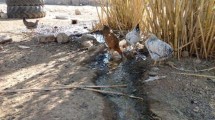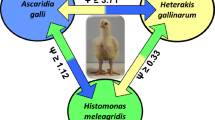Abstract
In the present investigation, three turkey lines, namely wild Canadian turkeys (WCT), British United turkey (BUT-Big6) and Kelly–Bronze turkeys (KBT) were compared for their susceptibility to infection with Histomonas meleagridis. All birds were kept on wood shaving as litter from day 1 on during the entire observation period. On day 28, 18–20 birds per turkey line were infected with H. meleagridis intracloacally. All birds were observed for 4 weeks after infection. The mortality rate was 95% in WCT, 78% in BUT-Big6 and 75% in KBT. In WCT, the first deaths occurred at day 6 and ended at day 13 post-infection, whilst for BUT-Big6 and KBT, birds died from days 10 to day 20. In KBT group, the mortality started at day 10 and lasted until day 17 after infection. At necropsy, all birds that died showed lesions typical for histomoniasis in the caeca and liver. The obtained results demonstrate that all tested turkey lines are susceptible to infection; however, the mortality rate for the wild Canadian turkey is statistically significantly higher compared to the other tested two lines.
Similar content being viewed by others
References
Al-Khateeb G, Hansen MF (1974) Plasma enzymes as a measure of susceptibility of chickens and turkeys to infection with Histomonas meleagridis. Avian Dis 18:507–514
Bumstead N, Millard BM, Barrow PA, Cook JKA (1991) Genetic basis of disease resistance in chickens. In: Owen JB, Axford RFE (eds) Breeding for disease resistance in farm animals. Commonwealth Agricultural Bureau, Wallingford, England, pp 10–23
Chossat L (2002) L’histomonose en production AOC “Dinde Fermie`re de Bresse.” Essai de prevention par phytothe’rapie. Veterinary thesis, University Claude Bernard, Lyon, France
Chute AM, Lund EE, Wilkins GC (1976) Comparative responses of white leghorn and New Hampshire chickens to experimental infections with Histomonas meleagridis and Heterakis gallinarum. Poultry Sci 55:710–713
Curtis C (1907) Notes on experiments with black-head of turkeys. USDA. Cir. 119 (cited from Chute et al. 1976)
Duffy CF, Sims MD, Power RFG (2005) Evaluation of dietary Natustat for control of Histomonas meleagridis in male turkeys on infected litter. Avian Dis 49:423–425
Grabensteiner E, Hess M (2006) PCR for the identification and differentiation of Histomonas meleagridis, Tetratrichomonas gallinarum and Blastocystis spp. Vet Parasitol 142:223–230
Grabensteiner E, Arshad N, Hess M (2007) Differences in the in vitro susceptibility of mono-eukaryotic cultures of Histomonas meleagridis, Tetratrichomonas gallinarum and Blastocystis sp. to natural organic compounds. Parasitol Res 101:193–199
Hafez HM, Hauck R (2006) Efficacy of a herbal product against Histomonas meleagridis after experimental infection of turkey poults. Arch Anim Nutr 60(5):436–442
Hafez HM, Schulze D, Hauck R, Lüschow D (2005a) Histomonas meleagridis: the situation after the ban of the last available drug in the EU. Proceedings of the 54th Western Poultry Disease Conference, Vancouver, BC, pp 36–38
Hafez HM, Hauck R, Lüschow D, McDougald LR (2005b) Comparison of the specificity and sensitivity of PCR, nested PCR, and real-time PCR for the diagnosis of histomoniasis. Avian Dis 49:366–370
Hauck R, Hafez HM (2007) Effect of coated plant extracts on Histomonas meleagridis and growth of bacteria in vitro. Avian Dis 51:880–883
Hauck R, Lüschow D, Hafez HM (2006) Detection of Histomonas meleagridis DNA in different organs after natural and experimental infections of meat turkeys. Avian Dis 50:35–38
Hess M, Grabensteiner E, Liebhart D (2006) Rapid transmission of the protozoan parasite Histomonas meleagridis in turkeys and specific pathogen free chickens following cloacal infection with a mono-eukaryotic culture. Avian Pathol 34:280–285
Hu J, McDougald LR (2002) Effect of anticoccidials and antibiotics on the control of Blackhead Disease in broiler breeder pullets. J Appl Poult Res 11:351–357
Hu J, McDougald LR (2004) The efficacy of some drugs with known antiprotozoal activity against Histomonas meleagridis in chickens. Vet Parasitol 121:233–238
Hu J, Fuller L, McDougald LR (2004) Infection of turkeys with Histomonas meleagridis by the cloacal drop method. Avian Dis 48:746–750
Lund EE (1955) The progress of histomoniasis (blackhead) in turkeys as related to the size of the infective dose. Poultry Sci 34:127–130
McDougald LR (2003) Other protozoan diseases of the intestinal tract—histomoniasis (blackhead). In: Saif YM, Barnes HJ, Glisson JR, Fadly AM, McDougald LR, Swayne DE (eds) Diseases of poultry, 11th edn. Iowa State Press, Ames, IA, pp 1001–101
McDougald LR, Hu J (2001) Blackhead disease (Histomonas meleagridis) aggravated in broiler chickens by concurrent infection with cecal coccidiosis (Eimeria tenella). Avian Dis 45:307–312
Permin A, Ranvig H (2001) Genetic resistance to Ascaridia galli infections in chickens. Vet Parasitol 102(2001):101–111
Pinard-Van der Laan MH, Monvoisin JL, Pery P, Hamet N, Thomas M (1998) Comparison of outbred lines of chickens for resistance to experimental infection with coccidiosis (Eimeria tenella). Poultry Sci 77:185–191
Reynaud M-C, Zenner L, Alogninouwa T, Chauve C-M (2005) Comparison of the susceptibility to Histomonas meleagridis infection of two strains of turkey (Meleagris gallopavo): preliminary study. Revue Méd Vét 156:620–623
Van der Heijden H, McDougald L, Landman WJM (2005) High yield of parasites and prolonged in vitro culture of Histomonas meleagridis. Avian Pathol 34:505–508
Van der Heijden HMJF, Landman WJM (2008) In vivo effect of herbal products against Histomonas meleagridis in turkeys. Avian Pathol 37(1):45–50
Zenner L, Callait MP, Granier C, Chauve C (2003) In vitro effect of essential oils from Cinnamomum aromaticum, Citrus limon, and Allium sativum on two intestinal flagellates of poultry, Tetratrichomonas gallinarum and Histomonas meleagridis. Parasite 10:153–157
Author information
Authors and Affiliations
Corresponding author
Rights and permissions
About this article
Cite this article
AbdulRahman, L., Hafez, H.M. Susceptibility of different turkey lines to Histomonas meleagridis after experimental infection. Parasitol Res 105, 113–116 (2009). https://doi.org/10.1007/s00436-009-1369-1
Received:
Accepted:
Published:
Issue Date:
DOI: https://doi.org/10.1007/s00436-009-1369-1




